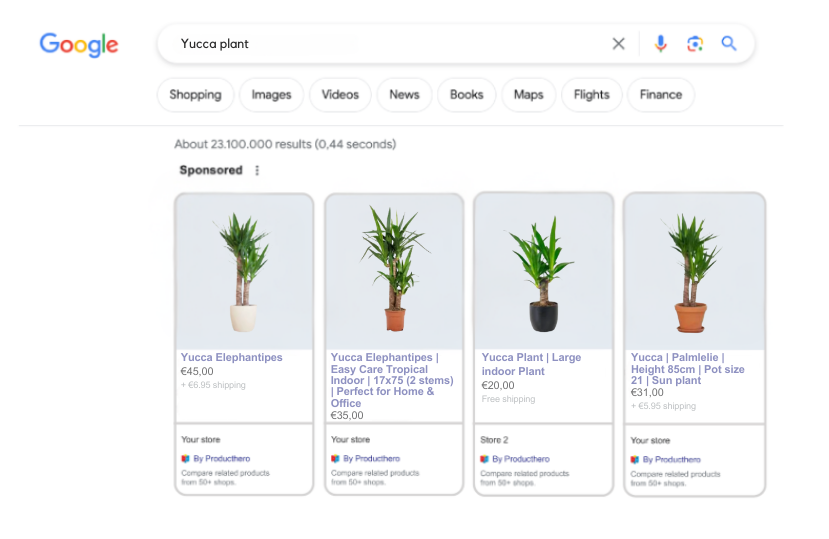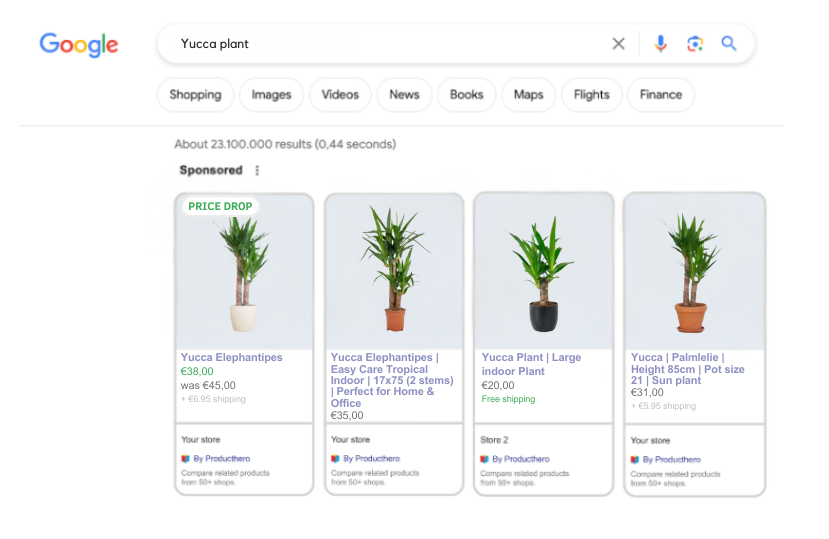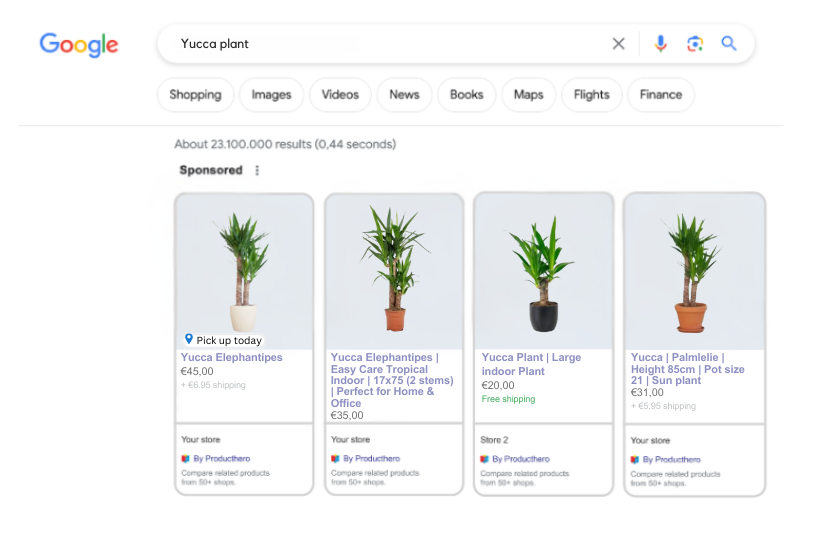Last updated on August 20, 2025
How to sell plants and flowers online – best practices
As gardening season approaches, plant and flower retailers have a great opportunity to attract customers through Google Shopping ads. This guide will walk you through understanding seasonal demand, optimizing product listings, and refining ad strategies to maximize the success of your campaigns.
Understanding seasonal demand
Selling plants and flowers means navigating distinct seasonal highs and lows. Demand shifts throughout the year, and a strong Google Ads strategy should align with these trends to maximize visibility and sales.
- Spring & Summer: High demand for outdoor plants, landscaping flowers, and vegetable seedlings as gardeners prepare for the growing season.
- Valentine’s Day & Mother’s Day: Increased interest in bouquets and potted gift plants.
- Winter Holidays: Popularity surges for poinsettias, festive centerpieces, and holiday decor.
Since peak demand periods are often short and intense, working with historical data is very important. Understanding how customer behaviour fluctuates based on past trends allows you to prepare inventory and advertising strategies accordingly. Weather patterns also play a significant role. For example, an early warm spell can prompt gardeners to buy outdoor plants sooner than expected, while an extended winter may delay purchases. Leveraging historical data alongside weather patterns can give you a competitive edge, ensuring you’re prepared for shifting demand.
Optimizing your Google Ads strategy
Adjusting performance tracking for seasonal peaks
As seasonal peaks approach, fine-tune your Google Ads settings for maximum impact. One important adjustment is shortening the performance tracking window. Instead of the default 30-day date range, try a shorter period (such as seven days) to get a clearer picture of trending products.
If you’re using the Producthero Platform, update your performance data dashboard accordingly. When setting up Producthero Labelizer, select a 7-day timeframe to ensure products are labeled based on their most recent performance.

Adjusting bids and budgets for peak demand
Competition among advertisers intensifies during peak seasons. To stay visible when customers are actively searching, temporarily increase daily budgets and bids. Allocate extra budget to high-performing products and monitor performance frequently to optimize spending.
Boost campaigns for targeted promotions
Grouping products into thematic campaigns helps target promotions effectively. Collections like “Spring Bloom Collection” or “Valentine’s Flowers” allow for better budget allocation. Running boost campaigns for trending plants, such as tulips in early spring, ensures they don’t compete directly with evergreen products, improving visibility and return on investment.
If you’re using Producthero Labelizer to segment products based on performance, check out this article on how to create a boost campaign alongside your Labelizer strategy.
Make your product listings stand out
Optimizing your ads titles
Google Shopping uses product titles and descriptions to match listings with search queries. The more detailed and relevant your titles, the better your chances of appearing in search results. Tools like Producthero Title Optimizer or Products AI can help speed up the process while maintaining consistency and effectiveness.

- For flowers: Mention type, colour, and size. Instead of a vague title like Spring Bouquet, use a more descriptive title such as Spring Bouquet – 20 Mixed Tulips in Vase – Fresh Garden Cut Flowers.
- For plants: Include species, pot size, light requirements, and indoor/outdoor suitability. Example: Snake Plant (Sansevieria) – 6” Pot – Low Light Indoor Houseplant. Including both the common and botanical names can help attract a wider audience, and specifying care instructions reassures buyers who are new to plant care.
- Use all available space: Google displays only the first 70 characters of your title in search results, so put the most important details upfront. But don’t neglect the rest: Google still considers the full 150-character title when ranking your listing.
Optimizing your product feed
A well-structured product feed is important for improving search relevance and customer experience.
- To maximize visibility, make sure to assign the correct Google Product Category (e.g., Home & Garden > Plants or Gifts > Flowers) and ensure there’s a clear and relevant product type hierarchy in place. You can refer to the full Google product taxonomy to help choose the most accurate category. Accurate categorisation enhances ad targeting and improves the user experience, making products more relevant to search queries.
- Include key product attributes such as colour, size, material (for pots or planters), and shipping weight and dimensions. This is especially important for heavy or delicate plants that require careful handling. Providing accurate shipping details ensures customers know what to expect, particularly when purchasing live plants that need special packaging.
- Enhance your product descriptions by including essential details like care instructions, blooming seasons, and unique characteristics. Highlighting benefits such as air purification or easy maintenance can make your listings more appealing, especially to beginner gardeners who may need extra guidance when selecting plants.
Competitive pricing and promotions
Pricing plays a key role in Google Shopping, especially for products that are widely available across multiple retailers (i.e. those sharing the same EAN). In these cases, customers can easily compare prices at a glance, and significantly higher prices may lead to fewer clicks (more about how price competitiveness influences shopping campaign performance in this article).
However, this doesn’t mean you always need to be the cheapest option. Many customers are willing to pay a little more for benefits like faster shipping, better service, or higher quality products. The key is understanding how your pricing positions you within the market.

- To stay competitive, regularly monitor how your prices compare to others. Tools like the Producthero Price Benchmark provide a clear dashboard displaying both performance data and price benchmarks. This helps you assess whether your products are priced above, below, or at market benchmarks while tracking their performance metrics.
- Running time-limited discounts, such as special offers for Mother’s Day or summer gardening sales, can help draw attention to your listings. Google might highlight your promotional pricing in search results, making discounted products more noticeable (more about sale price annotations in this article). You could also consider offering bundle deals to increase sales. For example, a “Buy 3, Get 1 Free” promotion on seedlings might encourage larger purchases.
Boosting in-store traffic with Local Inventory Ads

Not all customers want to wait for delivery, especially those looking for last-minute gifts or who prefer to pick out plants in person. Local Inventory Ads (LIAs) can bridge the gap between online and offline shopping by showing potential customers what’s in stock at your store when they search for plants or flowers online. To make the most of LIAs, ensure your store’s inventory is updated regularly, double-check that your store hours and location details are accurate in Google My Business to avoid any confusion.
To conclude, advertising plants and flowers on Google Shopping is about understanding customer behavior, responding to seasonal trends, and fine-tuning your strategy for maximum visibility. By keeping product listings detailed, adjusting bids during peak seasons, and offering competitive pricing and promotions, you can attract more buyers and boost sales.
